Heterogeneity in Education-Driven Residential Mobility: Evidence from Tianjin Under China’s School District System
Abstract
1. Introduction
1.1. Residential Relocation and Educational Capitalization Under the School District System
1.2. Residential Choices of Different Families and Social Differentiation Driven by Education
2. Materials and Methods
2.1. Sampling Site
2.2. Data Collection
2.3. Analytic Tool: K-Prototype
3. Results
3.1. Family Characteristics and Relocation Features of the Education-Driven Residential Mobility
3.1.1. Family Demographics
3.1.2. Spatial Features of Moving and Changes in the Housing Characteristics
3.2. The Heterogenicity of Education-Driven Residential Mobility
3.2.1. K-Prototype Analysis of Education-Driven Residential Mobility
3.2.2. Model Estimation for Cluster Analysis
3.2.3. Education-Driven Residential Mobility Patterns
- Cluster 1: Relocation of Wealthy Families to Key School Districts by Purchasing New Commercial Housing
- Cluster 2: Intra-District Relocation of Young Families to Purchase Second-Hand School District Housing
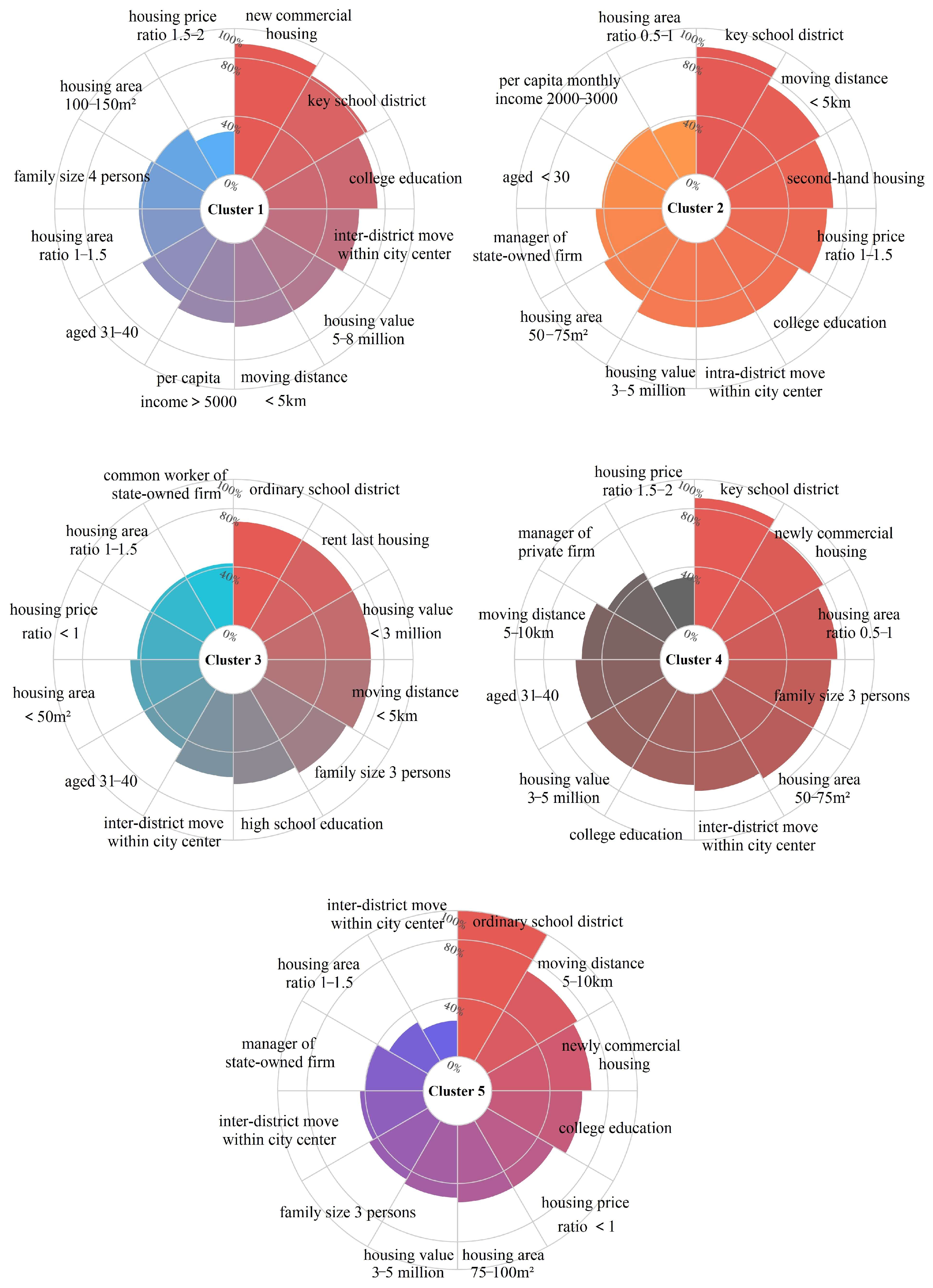
- Cluster 3: Short-Distance Relocation within the City Center to Change Home Ownership Status
- Cluster 4: Inter-district Relocation in Pursuit of Leading Schools while Reducing Housing Area
- Cluster 5: Long-distance Relocation of Middle-Aged Families to Increase Housing Size
4. Discussion
5. Conclusions
Author Contributions
Funding
Institutional Review Board Statement
Informed Consent Statement
Data Availability Statement
Conflicts of Interest
References
- Bridge, G. It’s not just a question of taste: Gentrification, the neighbourhood, and cultural capital. Environ. Plan. A Econ. Space 2006, 30, 1965–1978. [Google Scholar] [CrossRef]
- Liu, Y.; Yu, S.; Sun, T. Heterogeneous housing choice and residential mobility under housing reform in China: Evidence from Tianjin. Appl. Geogr. 2021, 129, 102417. [Google Scholar] [CrossRef]
- Frenkel, A.; Bendit, E.; Kaplan, S. Residential location choice of knowledge-workers: The role of amenities, workplace and lifestyle. Cities 2013, 35, 33–41. [Google Scholar] [CrossRef]
- Lawton, P.; Murphy, E.; Redmond, D. Residential preferences of the ‘creative class’? Cities 2013, 31, 47–56. [Google Scholar] [CrossRef]
- Wu, Q.; Edensor, T.; Cheng, J. Beyond space: Spatial (re)production and middle-class remaking driven by Jiaoyufication in Nanjing city, China. Int. J. Urban Reg. Res. 2018, 42, 1–19. [Google Scholar] [CrossRef]
- Yang, Z.; Hao, P.; Wu, D. Children’s education or parents’ employment: How do people choose their place of residence in Beijing. Cities 2019, 93, 197–205. [Google Scholar] [CrossRef]
- Wu, Q.; Zhang, X.; Waley, P. When Neil Smith met Pierre Bourdieu in Nanjing, China: Bringing cultural capital into rent gap theory. Hous. Stud. 2017, 32, 659–677. [Google Scholar] [CrossRef]
- Chen, J.; Li, R. Pay for elite private schools or pay for higher housing prices? Evidence from an exogenous policy shock. J. Hous. Econ. 2023, 60, 101934. [Google Scholar] [CrossRef]
- Wu, Q.; Zhang, X.; Waley, P. Jiaoyufication: When gentrification goes to school in the Chinese inner city. Urban Stud. 2016, 53, 3510–3526. [Google Scholar] [CrossRef]
- Huang, B.; He, X.; Xu, L.; Zhu, Y. Elite school designation and housing prices-quasi-experimental evidence from Beijing, China. J. Hous. Econ. 2020, 50, 101730. [Google Scholar] [CrossRef]
- You, Y. A deep reflection on the “key school system” in basic education in China. Front. Educ. China 2007, 2, 229–239. [Google Scholar] [CrossRef]
- Feng, H.; Lu, M. School quality and housing prices: Empirical evidence from a natural experiment in Shanghai, China. J. Hous. Econ. 2013, 22, 291–307. [Google Scholar] [CrossRef]
- Jin, Z.; Wang, X.; Huang, B. The enrolment reform of schools and housing price: Empirical evidence from Shanghai, China. Int. Rev. Econ. Financ. 2023, 84, 262–273. [Google Scholar] [CrossRef]
- Zahirovic-Herbert, V.; Turnbull, G.K. School quality, house prices and liquidity. J. Real Estate Financ. Econ. 2008, 37, 113–130. [Google Scholar] [CrossRef]
- Haisken-DeNew, J.; Hasan, S.; Jha, N.; Sinning, M. Unawareness and selective disclosure: The effect of school quality information on property prices. J. Econ. Behav. Organ. 2018, 145, 449–464. [Google Scholar] [CrossRef]
- Gibbons, S.; Machin, S. Valuing school quality, better transport, and lower crime: Evidence from house prices. Oxf. Rev. Econ. Policy 2008, 24, 99–119. [Google Scholar] [CrossRef]
- Hamnett, C.; Butler, T. “Geography matters”: The role distance plays in reproducing educational inequality in East London. Trans. Inst. Br. Geogr. 2011, 36, 479–500. [Google Scholar] [CrossRef]
- Zheng, S.; Hu, W.; Wang, R. How much is a good school worth in Beijing? Identifying price premium with paired resale and rental data. J. Real Estate Financ. Econ. 2016, 53, 184–199. [Google Scholar] [CrossRef]
- Chan, J.; Fang, X.; Wang, Z.; Zai, X.; Zhang, Q. Valuing primary schools in urban China. J. Urban Econ. 2020, 115, 103183. [Google Scholar] [CrossRef]
- Cellini, S.R.; Ferreira, F.; Rothstein, J. The value of school facility investments: Evidence from a dynamic regression discontinuity design. Q. J. Econ. 2010, 125, 215–261. [Google Scholar] [CrossRef]
- Wen, H.; Zhang, Y.; Zhang, L. Do educational facilities affect housing price? An empirical study in Hangzhou, China. Habitat Int. 2014, 42, 155–163. [Google Scholar] [CrossRef]
- Peng, Y.; Tian, C.; Wen, H. How does school district adjustment affect housing prices: An empirical investigation from Hangzhou, China. China Econ. Rev. 2021, 69, 101683. [Google Scholar] [CrossRef]
- Deurloo, M.C.; Clark, W.A.V.; Dieleman, F.M. The move to housing ownership in temporal and regional contexts. Environ. Plan. A Econ. Space 1994, 26, 1659–1670. [Google Scholar] [CrossRef]
- Wu, Y.; Coulter, R.; Dennett, A. Understanding the relationships between the family structures and destinations of married migrants with children in China. Appl. Geogr. 2023, 160, 103102. [Google Scholar] [CrossRef]
- Davis-Kean, P.E. The influence of parent education and family income on child achievement: The indirect role of parental expectations and the home environment. J. Fam. Psychol. 2005, 19, 294–304. [Google Scholar] [CrossRef]
- Noden, P.; West, A.; David, M.; Edge, A. Choices and destinations at transfer to secondary schools in London. J. Educ. Policy 1998, 13, 221–236. [Google Scholar] [CrossRef]
- Clark, W.; Deurloo, M.; Dieleman, F. Residential mobility and neighbourhood outcomes. Hous. Stud. 2006, 21, 323–342. [Google Scholar] [CrossRef]
- Rabe, B.; Taylor, M. Residential mobility, quality of neighbourhood and life course events. J. R. Stat. Soc. Ser. A Stat. Soc. 2010, 173, 531–555. [Google Scholar] [CrossRef]
- Butler, T.; Hamnett, C.; Ramsden, M.J. Gentrification, education and exclusionary displacement in East London. Int. J. Urban Reg. Res. 2013, 37, 556–575. [Google Scholar] [CrossRef]
- Xiang, L.; Gould, M.; Stillwell, J. What determines pupils’ travel distance to school in China? A multilevel analysis of educational access in Beijing. Urban Stud. 2022, 59, 1048–1067. [Google Scholar] [CrossRef]
- Yang, Z.; Cai, J.; Qi, W.; Liu, S.; Deng, Y. The influence of income, lifestyle, and green spaces on interregional migration: Policy implications for China. Popul. Space Place 2017, 23, e1996. [Google Scholar] [CrossRef]
- Yang, Z.; Dunford, M. City shrinkage in China: Scalar processes of urban and hukou population losses. Reg. Stud. 2018, 52, 1111–1121. [Google Scholar] [CrossRef]
- Zhou, X.; Moen, P.; Tuma, N.B. Educational stratification in urban China: 1949–94. Sociol. Educ. 1998, 71, 199. [Google Scholar] [CrossRef]
- Smith, D.P.; Holt, L. Studentification and ‘apprentice’ gentrifiers within Britain’s provincial towns and cities: Extending the meaning of gentrification. Environ. Plan. A Econ. Space 2007, 39, 142–161. [Google Scholar] [CrossRef]
- Friedman, J. A conditional logit model of the role of local public services in residential choice. Urban Stud. 1981, 18, 347–358. [Google Scholar] [CrossRef]
- Gober, P.; McHugh, K.E.; Reid, N. Phoenix in flux: Household instability, residential mobility, and neighborhood change. Ann. Assoc. Am. Geogr. 1991, 81, 80–88. [Google Scholar] [CrossRef]
- Henderson, J.V.; Ioannides, Y.M. Dynamic aspects of consumer decisions in housing markets. J. Urban Econ. 1989, 26, 212–230. [Google Scholar] [CrossRef]
- Li, S.; Zhu, Y.; Li, L. Neighborhood type, gatedness, and residential experiences in Chinese cities: A study of Guangzhou. Urban Geogr. 2012, 33, 237–255. [Google Scholar] [CrossRef]
- Tianjin Municipal Bureau of Statistics. Available online: https://stats.tj.gov.cn/nianjian/2024nj/zk/indexch.htm (accessed on 8 February 2025).
- Wang, Y.; Sun, T.; Wu, F.; Zhai, L.; Li, C.; Sun, X.; Hu, W.; Du, P.; Zhang, L.; Zheng, F.; et al. The Re-Making of Chinese Urban Neighbourhoods: Case Studies in Tianjin, Chengdu and Hangzhou 2016–2019; UK Data Service: Colchester, UK, 2020. [Google Scholar] [CrossRef]
- Breen, R.; Karlson, K.B. Education and Social Mobility: New Analytical Approaches. Eur. Sociol. Rev. 2013, 30, 107–118. [Google Scholar] [CrossRef]
- Collins, J. Social Reproduction in Classrooms and Schools. Annu. Rev. Anthropol. 2009, 38, 33–48. [Google Scholar] [CrossRef]
- Petrik, F. Schooling Inequality: Aspirations, Opportunities and the Reproduction of Social Class. Br. J. Educ. Stud. 2025, 73, 273–276. [Google Scholar] [CrossRef]
- Butler, T.; Hamnett, C. The Geography of Education: Introduction. Urban Stud. 2007, 44, 1161–1174. [Google Scholar] [CrossRef]
- Putnam, R.D. Bowling Alone: The Collapse and Revival of American Community; Simon and Schuster: New York, NY, USA, 2000; 541p. [Google Scholar] [CrossRef]
- Hipp, J.R.; Perrin, A.J. The Simultaneous Effect of Social Distance and Physical Distance on the Formation of Neighborhood Ties. City Community 2009, 8, 5–25. [Google Scholar] [CrossRef]
- Wen, H.; Xiao, Y.; Zhang, L. School district, education quality, and housing price: Evidence from a natural experiment in Hangzhou, China. Cities 2017, 66, 72–80. [Google Scholar] [CrossRef]
- Mathur, S. The Myth of “Free” Public Education: Impact of School Quality on House Prices in the Fremont Unified School District, California. J. Plan. Educ. Res. 2017, 37, 176–194. [Google Scholar] [CrossRef]
- DiSalvo, R.W.; Yu, J.H. Housing Affordability and School Quality in the United States. J. Hous. Econ. 2023, 60, 101933. [Google Scholar] [CrossRef]
- Guan, R.; Liang, J.; Koo, K.M.; Su, K. Fairer schooling for a better housing environment: Effect of abolishing school zones on the housing market. Habitat Int. 2024, 153, 103199. [Google Scholar] [CrossRef]
- Du, Z.; Zhang, L. Home-purchase restriction, property tax and housing price in China: A counterfactual analysis. J. Econom. 2015, 188, 558–568. [Google Scholar] [CrossRef]
- Gulson, K.N.; Fataar, A. Neoliberal governmentality, schooling and the city: Conceptual and empirical notes on and from the Global South. Discourse Stud. Cult. Politics Educ. 2011, 32, 269–283. [Google Scholar] [CrossRef]
- Zhao, Y.; Ma, J.; Lan, Z. Balancing education and real estate: The impact of the teacher rotation policy on school district housing prices. Financ. Res. Lett. 2024, 69, 106131. [Google Scholar] [CrossRef]
- Zangger, C. The social geography of education: Neighborhood, class composition, and the educational achievement of elementary school students in Zurich, Switzerland. Z. Für Soziologie 2015, 44, 292–314. [Google Scholar] [CrossRef][Green Version]
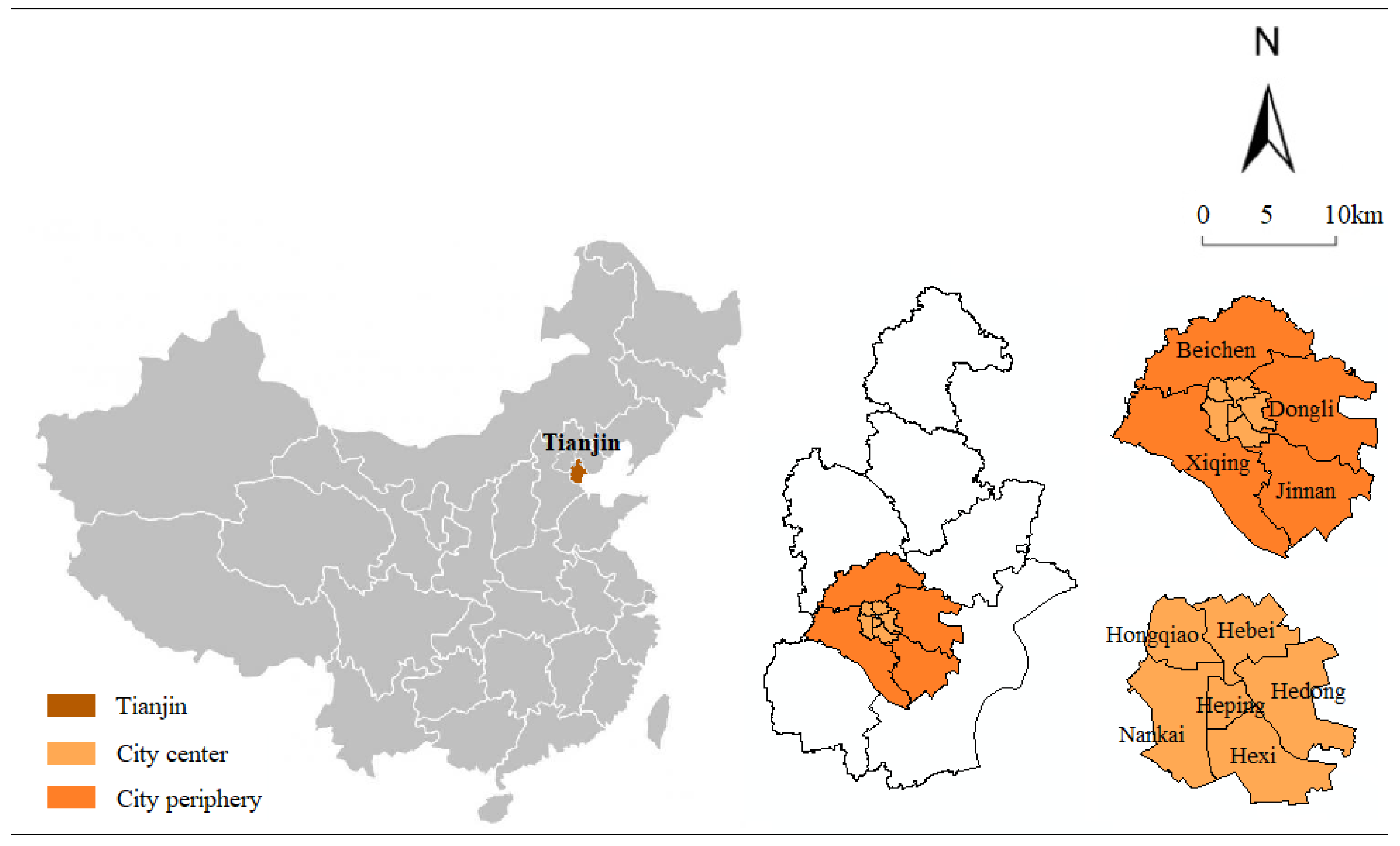
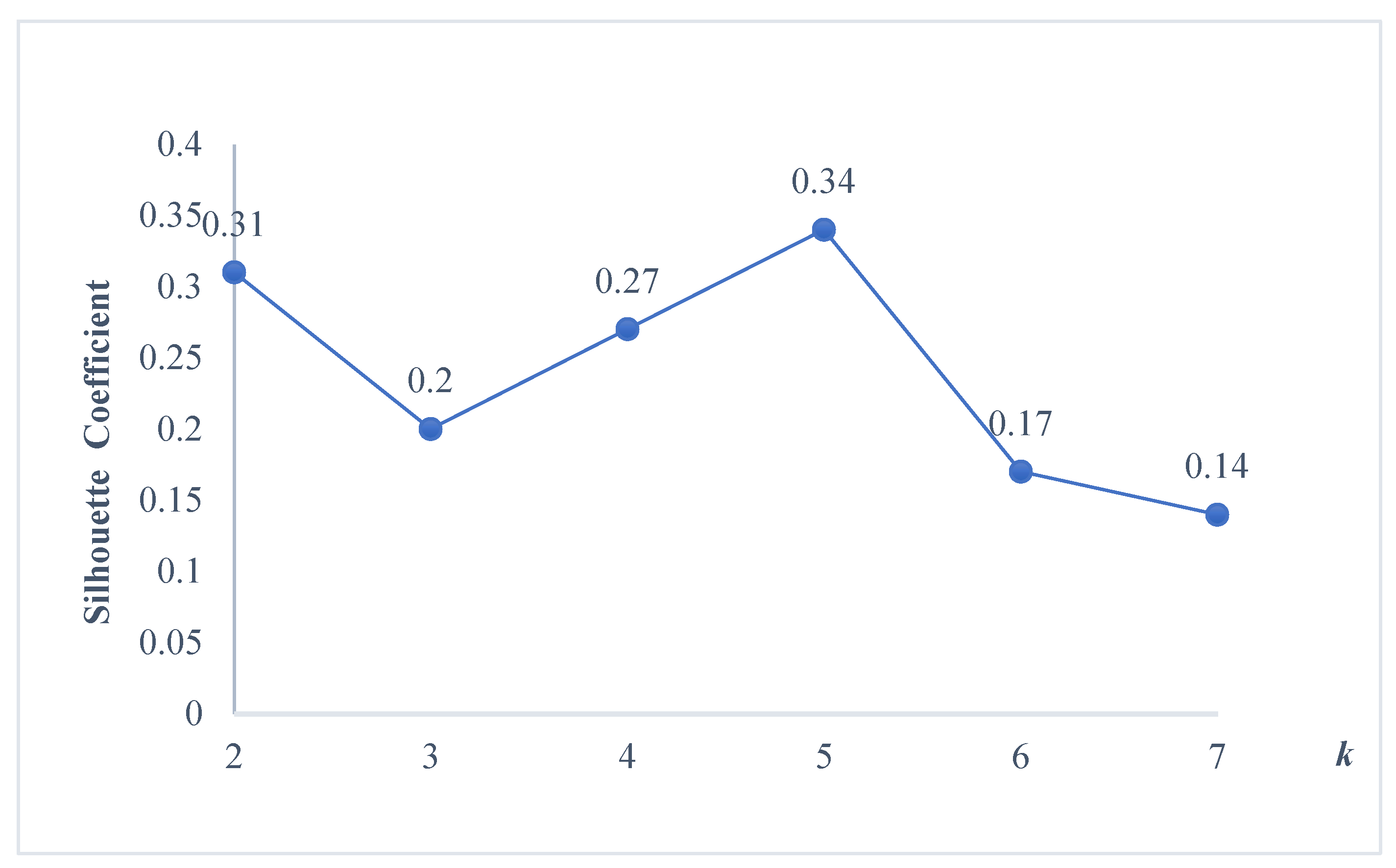
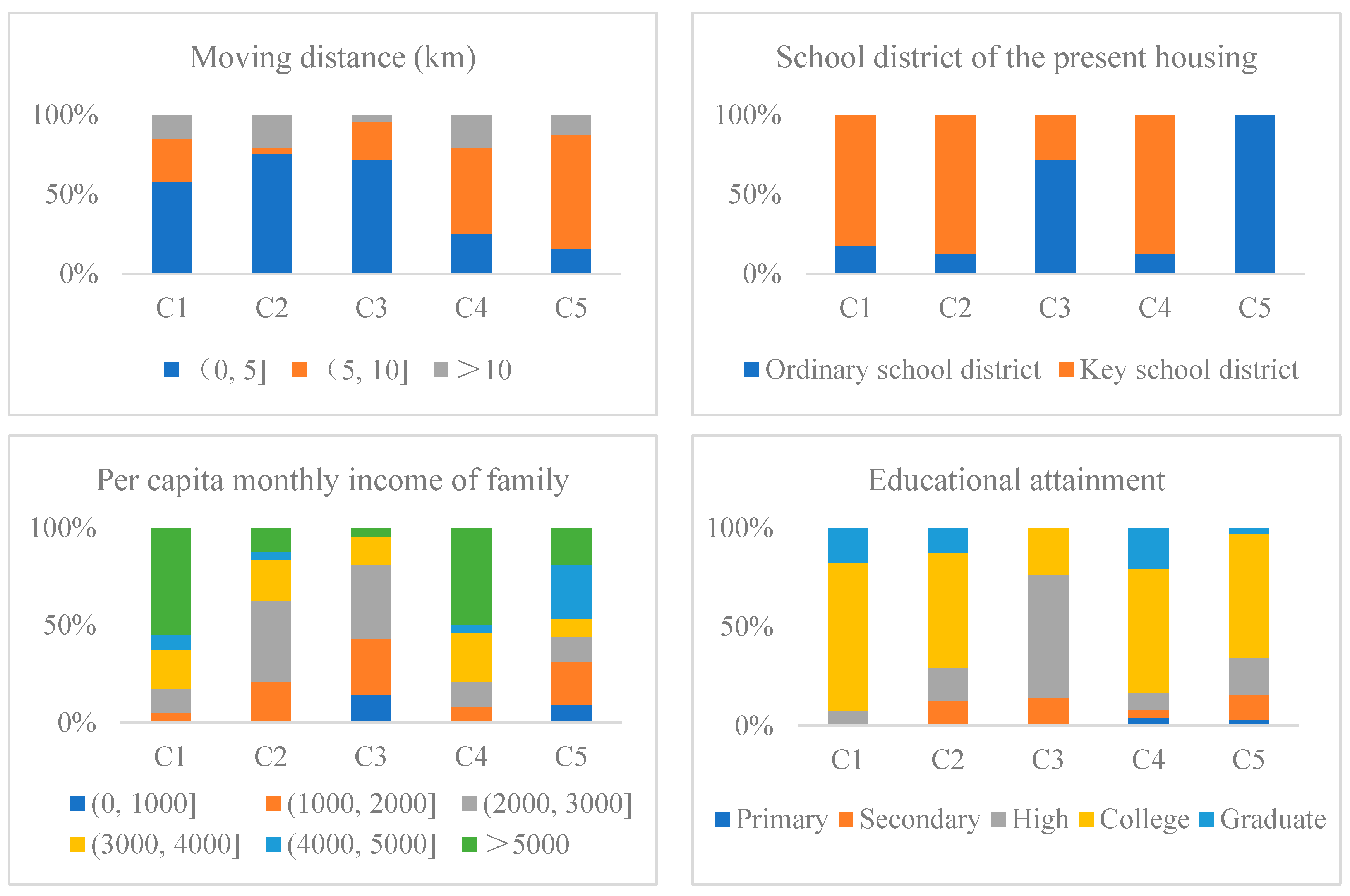
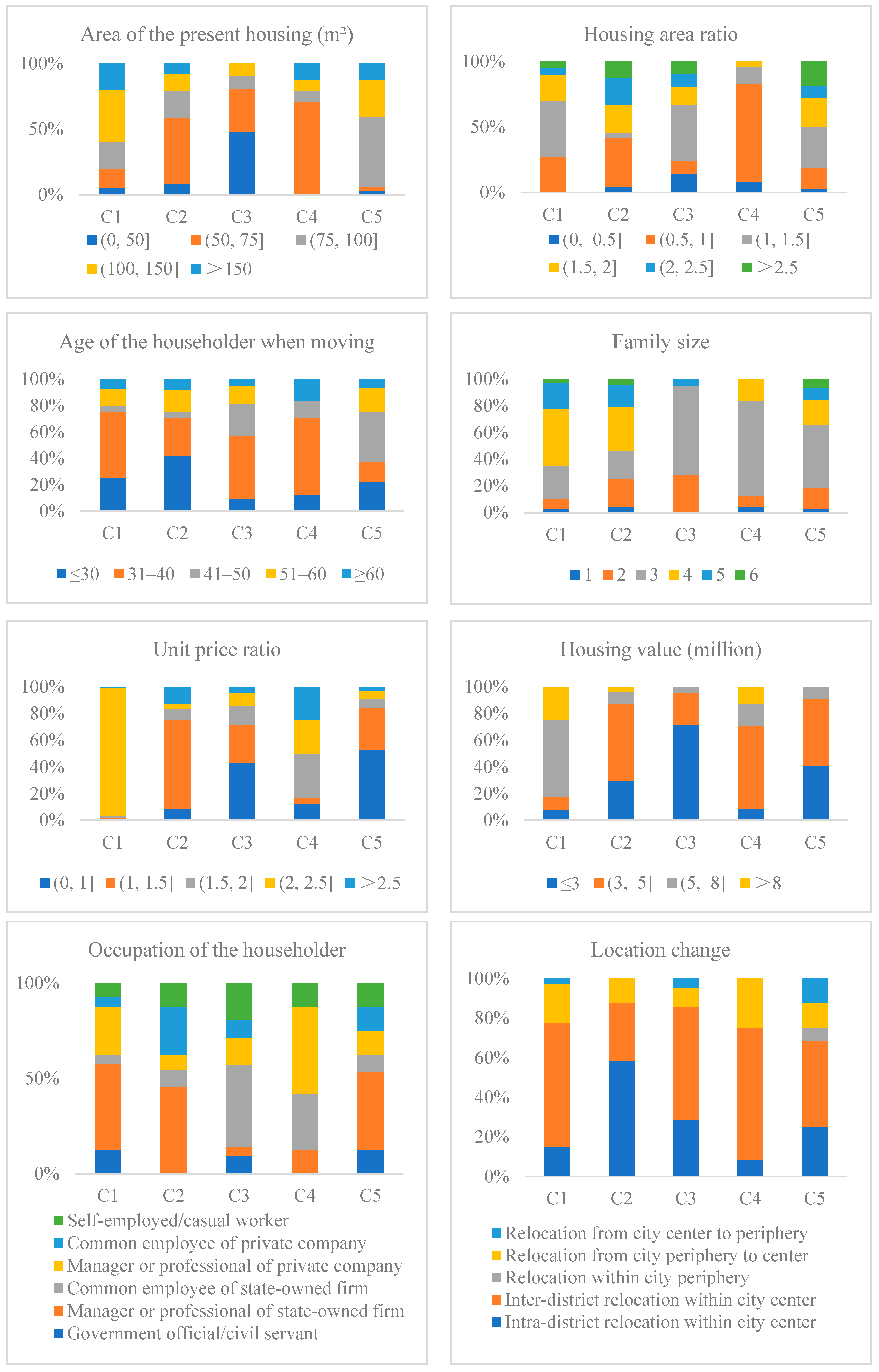

| Attribute | Category/Value | Proportion |
|---|---|---|
| Family size | 1 | 2.84% |
| 2 | 14.89% | |
| 3 | 43.26% | |
| 4 | 24.82% | |
| 5 | 11.35% | |
| 6 | 2.84% | |
| Age of the householder when moving | ≤30 | 22.70% |
| 31–40 | 39.72% | |
| 41–50 | 16.31% | |
| 51–60 | 12.77% | |
| ≥60 | 8.51% | |
| Sex of the householder | Male | 67.38% |
| Female | 32.62% | |
| Educational attainment of the householder | Primary | 1.42% |
| Secondary | 7.80% | |
| High | 19.86% | |
| College | 59.57% | |
| Graduate | 11.35% | |
| Householder’s occupation | Government official/civil servant | 7.80% |
| Manager or professional of state-owned enterprise | 32.62% | |
| Common employee of state-owned enterprise | 16.31% | |
| Manager or professional of private or foreign company | 21.28% | |
| Common employee of private or foreign company | 9.93% | |
| Self-employed/casual worker | 12.06% | |
| Hukou of the householder | Tianjin hukou within city center | 96.45% |
| Tianjin hukou within city periphery | 0.71% | |
| Urban hukou outside Tianjin | 1.42% | |
| Rural hukou outside Tianjin | 1.42% | |
| Per capita monthly income of the family | (0, 1000] | 4.26% |
| (1000, 2000] | 15.60% | |
| (2000, 3000] | 21.28% | |
| (3000, 4000] | 17.73% | |
| (4000, 5000] | 9.93% | |
| >5000 | 31.21% |
| Attribute | Category | Proportion |
|---|---|---|
| Moving distance(km) | (0, 5] | 47.52% |
| (5, 10] | 37.59% | |
| >10 | 14.89% | |
| Location change | Intra-district relocation within city center | 25.53% |
| Inter-district relocation within city center | 52.48% | |
| Relocation within city periphery | 1.42% | |
| Relocation from city periphery to center | 16.31% | |
| Relocation from city center to periphery | 4.26% | |
| School district of the present housing | Ordinary school district | 42.55% |
| Key school district | 57.45% | |
| Area of the present housing(m2) | (0, 50] | 10.64% |
| (50, 75] | 30.50% | |
| (75, 100] | 24.11% | |
| (100, 150] | 22.70% | |
| >150 | 12.06% | |
| Housing area ratio (present housing/old housing) | (0, 0.5] | 4.96% |
| (0.5, 1] | 31.91% | |
| (1, 1.5] | 28.37% | |
| (1.5, 2] | 17.02% | |
| (2, 2.5] | 8.51% | |
| >2.5 | 9.22% | |
| Total price value for the present housing (million CNY) | ≤3 | 28.37% |
| (3, 5] | 38.30% | |
| (5, 8] | 23.40% | |
| >8 | 9.93% | |
| Unit price ratio (present housing/old housing) | (0, 1] | 24.82% |
| (1, 1.5] | 29.79% | |
| (1.5, 2] | 19.15% | |
| (2, 2.5] | 12.77% | |
| >2.5 | 13.48% | |
| Ownership of the present housing | Self-owned commercial housing | 60.28% |
| Self-owned affordable housing | 0.71% | |
| Self-owned second-hand housing | 25.53% | |
| Self-owned work-unit housing | 5.67% | |
| Self-owned resettlement housing | 1.42% | |
| Rent | 6.38% | |
| Ownership of the last housing | Self-owned commercial housing | 46.81% |
| Self-owned affordable housing | 0.71% | |
| Self-owned second-hand housing | 6.38% | |
| Self-owned work-unit housing | 7.80% | |
| Self-owned resettlement housing | 1.42% | |
| Rent | 33.33% | |
| Other | 3.55% |
| Categorical Attributes | Category | Code | Min | Max |
|---|---|---|---|---|
| Ownership of the present housing | Self-owned commercial housing | 1 | 1 | 6 |
| Self-owned affordable housing | 2 | |||
| Self-owned second-hand housing | 3 | |||
| Self-owned work-unit housing | 4 | |||
| Self-owned resettlement housing | 5 | |||
| Rent | 6 | |||
| Ownership of the last housing | Self-owned commercial housing | 1 | 1 | 7 |
| Self-owned affordable housing | 2 | |||
| Self-owned second-hand housing | 3 | |||
| Self-owned work-unit housing | 4 | |||
| Self-owned resettlement housing | 5 | |||
| Rent | 6 | |||
| Other | 7 | |||
| Location change | Intra-district relocation within city center | 1 | 1 | 5 |
| Inter-district relocation within city center | 2 | |||
| Relocation within city periphery | 3 | |||
| Relocation from city periphery to center | 4 | |||
| Relocation from city center to periphery | 5 | |||
| Unit price ratio (present housing/old housing) | (0, 1] | 1 | 1 | 5 |
| (1, 1.5] | 2 | |||
| (1.5, 2] | 3 | |||
| (2, 2.5] | 4 | |||
| >2.5 | 5 | |||
| Housing area ratio (present housing/old housing) | (0, 0.5] | 1 | 1 | 6 |
| (0.5, 1] | 2 | |||
| (1, 1.5] | 3 | |||
| (1.5, 2] | 4 | |||
| (2, 2.5] | 5 | |||
| >2.5 | 6 | |||
| Moving distance(km) | (0, 5] | 1 | 1 | 3 |
| (5, 10] | 2 | |||
| >10 | 3 | |||
| Age of the householder when moving | ≤30 | 1 | 1 | 5 |
| 31–40 | 2 | |||
| 41–50 | 3 | |||
| 51–60 | 4 | |||
| ≥60 | 5 | |||
| Educational attainment of the householder | Primary | 1 | 1 | 5 |
| Secondary | 2 | |||
| High | 3 | |||
| College | 4 | |||
| Graduate | 5 | |||
| Sex of the householder | Male | 1 | 1 | 2 |
| Female | 2 | |||
| Householder’s occupation | Government official/civil servant | 1 | 1 | 6 |
| Manager or professional of state-owned enterprise | 2 | |||
| Common employee of state-owned enterprise | 3 | |||
| Manager or professional of private or foreign company | 4 | |||
| Common employee of private or foreign company | 5 | |||
| Self-employed/casual worker | 6 | |||
| Hukou of the householder | Tianjin hukou within city center | 1 | 1 | 4 |
| Tianjin hukou within city periphery | 2 | |||
| Urban hukou outside Tianjin | 3 | |||
| Rural hukou outside Tianjin | 4 | |||
| School district of the present housing | Ordinary school district | 1 | 1 | 2 |
| Key school district | 2 |
Disclaimer/Publisher’s Note: The statements, opinions and data contained in all publications are solely those of the individual author(s) and contributor(s) and not of MDPI and/or the editor(s). MDPI and/or the editor(s) disclaim responsibility for any injury to people or property resulting from any ideas, methods, instructions or products referred to in the content. |
© 2025 by the authors. Licensee MDPI, Basel, Switzerland. This article is an open access article distributed under the terms and conditions of the Creative Commons Attribution (CC BY) license (https://creativecommons.org/licenses/by/4.0/).
Share and Cite
Yin, Y.; Yu, S.; Sun, T. Heterogeneity in Education-Driven Residential Mobility: Evidence from Tianjin Under China’s School District System. Sustainability 2025, 17, 8326. https://doi.org/10.3390/su17188326
Yin Y, Yu S, Sun T. Heterogeneity in Education-Driven Residential Mobility: Evidence from Tianjin Under China’s School District System. Sustainability. 2025; 17(18):8326. https://doi.org/10.3390/su17188326
Chicago/Turabian StyleYin, Yue, Sihang Yu, and Tao Sun. 2025. "Heterogeneity in Education-Driven Residential Mobility: Evidence from Tianjin Under China’s School District System" Sustainability 17, no. 18: 8326. https://doi.org/10.3390/su17188326
APA StyleYin, Y., Yu, S., & Sun, T. (2025). Heterogeneity in Education-Driven Residential Mobility: Evidence from Tianjin Under China’s School District System. Sustainability, 17(18), 8326. https://doi.org/10.3390/su17188326








